(148 products available)












































































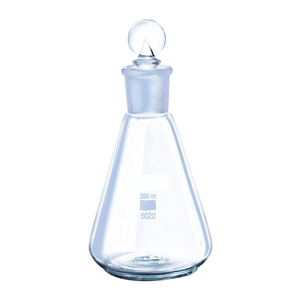
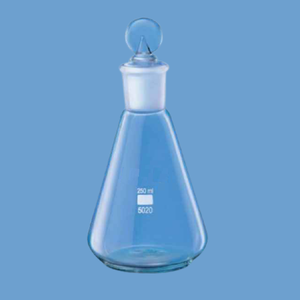
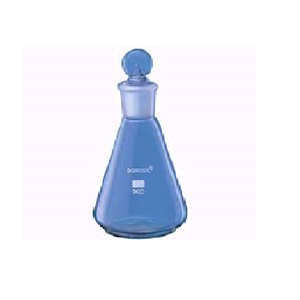
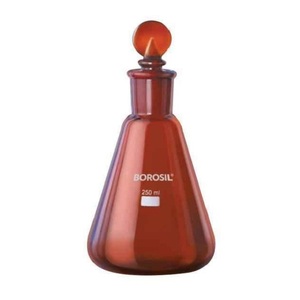
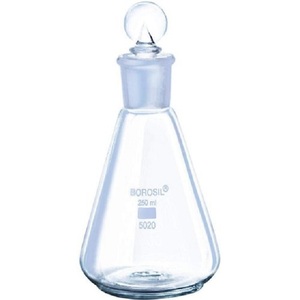















































































Erlenmeyer flask stoppers come in various types, each tailored for specific application needs. Choosing the correct stopper is crucial for laboratory work, especially concerning the materials being used and the function of the Erlenmeyer flask.
Cork stoppers are mainly used due to their biodegradability and excellent sealing capability. The natural elasticity of cork allows for a tight fit on various flask sizes while adapting to diverse neck shapes. This cork durability makes it ideal for long-term use in slow chemical reactions or on samples that require minimal air exposure. Moreover, being lightweight, these stoppers are easy to handle when carrying equipment in the lab. Added to all this, cork is very affordable.
Rubber stoppers offer chemical resistance and are used widely to seal Erlenmeyer flasks in most laboratories. This synthetic elastic material is adaptable, making it useful for suspending or sealing flasks with various neck dimensions. Rubber stoppers are better suited to flasks used with chemicals, solvents, and acids since cork is porous and may absorb some of these substances. With a long lifespan, rubber stoppers are excellent for sealing flasks in reactions likely to release gases or those that need to be kept under pressure.
PTFE stoppers provide chemical resistance and sealing properties and are ideal for high-value applications. PTFE, or Teflon, is a very dense plastic used in laboratories that deal in chemicals and processes involving high temperatures. Since porous PTFE does not interact with chemicals or easily degrade over time, it is practical in areas where contamination or frequent stopper replacement would be a problem. PTFE stoppers may come with a hole for experimental setups using stoppers for addition funnels in reactions.
Glass stoppers are not only attractive but also useful in providing pure, uncontaminated seals for Erlenmeyer flasks. They are used in laboratories working with volatile chemicals or where the highest level of sample integrity is required. Glass, being non-reactive and coming to fit perfectly, reduces chemical leaching. Furthermore, the visual nature of the glass prevents users from missing important details found on stoppers such as markings or labels. What is critical to note is that glass stoppers, though elegant, must be handled with care to avoid breakage and will not provide sealing like rubber or corks.
The main function of an Erlenmeyer flask stopper is the proper sealing of the flask. This helps maintain the contents within the flask, especially when conducting chemical reactions, storing biological samples, or working with volatile substances. Further, the stop aids in controlling vapor emissions, minimizing contamination intake, and preventing potential hazardous gas accumulation within the flask from escaping.
Cork and rubber stoppers are often used in experiments such as fermentation, where gas production is part of the process, and the stopper helps to release the gas without allowing the contents to be exposed to air. PTFE stoppers also have a similar function in reactive chemical contexts, where the chemical inertness of the PTFE helps keep the system intact. Some stoppers have holes in them to allow the passage of air or other materials, which may produce a need to have a stopper in certain experiments.
Erlenmeyer flask stopper features depend a lot on the materials used in their making and their design. Rubber stoppers are flexible, making them suitable for flasks with various neck sizes. PTFE stoppers, on the other hand, are suitable for highly reactive contexts. PTFE and cork stoppers are chemically inert; hence, they do not react with their environment, unlike rubber stoppers, which may degrade on exposure to some chemicals.
Some stoppers are designed with one or more drilled holes to accommodate glassware connectors for experiments that require air or liquid transfer. Stoppers come in various sizes, making it vital to select the correct size to achieve a proper seal. Depending on their intended application, some stoppers might also be fabricated to withstand extreme temperatures.
The design of an Erlenmeyer flask stopper has a significant effect on its efficacy. Most stoppers are cone-shaped and tapered to ease their insertion into the neck of a flask. This tapering permits stoppers of various sizes to achieve a tight fit where necessary. Those incorporated with holes in their design facilitate additional apparatus attachment for complex experimental setups.
In terms of dimensions, stoppers are available in various diameters and lengths, and the exact sizes are standardized to fit the typical neck sizes of various flasks. PTFE stoppers have also been created to include extensions or other forms of accessories for use in vacuum or pressure experiments. Threaded stoppers offer better seals than cork or rubber stoppers and may have adjustable fits.
Used in laboratories for various tasks, Erlenmeyer flask stoppers, play a crucial part in experimental safety and procedure. Their flexibility makes them suitable for use in chemical, biological, and industrial processes.
An Erlenmeyer flask stopper is essential when carrying out chemical experiments, especially when sealing reaction mixtures under conditions that may lead to evaporation. For reactions producing gases, stoppers with holes allow gas escape and prevent pressure buildup within the flask. Other than that, flasks containing volatile liquid solvents sealed with rubber or cork stoppers help decrease evaporation and maintain system stability.
Biological samples such as cell cultures, DNA, and other sensitive biological products are usually kept in Erlenmeyer flasks sealed with cork or rubber stoppers. These stoppers keep samples protected from environmental factors like moisture and air. PTFE stoppers are used to hold biologically sensitive samples against chemical contamination. It does not interact with biological samples, ensuring they remain pure and intact throughout preservation.
In brewing and winemaking industries, fermentation processes occur in vessels sealed with Erlenmeyer flask stoppers. The stopper allows by-product gas expulsion while preventing outside air from entering. This is critical in fermentation, as any oxygen entering may affect the final product negatively. Rubber stoppers are the most preferred due to their flexibility and ability to create an airtight seal.
Vacuum or pressure-related experimentation in laboratories normally deploys PTFE or rubber stoppers to secure the contents of the flask during experimental conditions. PTFE stoppers are appropriate for ultra-chemical-sensitive processes where conventional rubber may not endure due to chemical interactions. Threaded stoppers provide additional sealing that may be required to stop the escape of gases under pressure or the ingress of air under vacuum conditions.
Selecting the correct Erlenmeyer flask stopper depends on many factors. Below are several key considerations to make the selection process seamless.
The material of the stopper should be compatible with the chemicals in the flask. Rubber stoppers may degrade when exposed to strong acids or organic solvents. Thus, PTFE or glass stoppers are preferred for such experiments. Cork stoppers, while less durable, are suitable for low-risk chemicals and slow reactions due to their easy breakability. This makes it easy to identify the compatibility of the materials.
The size of the stopper must match that of the flask neck opening to ensure a proper fit. Using incorrectly sized stoppers creates the risk of poor sealing due to leakage or entry of contaminants. On the other hand, over-stretching the stopper will also break it. Available stoppers are usually standard in size, which means they can easily fit most laboratory flasks. However, one might need to take measurements to ensure the right size for unique equipment.
Considerations of the experimental conditions encompass factors such as temperature. If experiments are conducted at elevated temperatures or involve cryogenic substances, the stopper must be heat- or cold-resistant, such as PTFE or glass. Rubber stoppers do not have this property since they degrade upon exposure to heat and chemicals. PTFE stoppers are manufactured to resist extreme temperatures. PTFE stoppers are also durable, making them suitable for long-term experiments involving the same chemicals.
If the experiment requires the addition of reagents or the need to release gases periodically, a stopper with a hole is significant. Such stoppers allow an easy attachment of tubing or other apparatus without having to remove the stopper frequently. Hence, one can maintain the experiment's workflow. For experiments not requiring extra space, conventional solid stoppers are sufficient for general sealing purposes.
A1: Erlenmeyer flask stoppers are used to seal off flasks to prevent the contents from evaporating, reacting with the air, or escaping. They also help maintain pressure within the system while preventing environmental contaminants from entering the flask.
A2: Rubber stoppers are generally better as they hold up against chemicals and acids. Cork over time may degrade if exposed continuously to strong chemicals. Rubber stoppers are often used where air exposure is undesirable, as cork may absorb some chemical vapors over time.
A3: PTFE stoppers are most suited for chemically sensitive procedures since they are inert. Thus, they will not react with the contents of the flask, making them appropriate for experiments requiring long-term stability and purity. PTFE stoppers are also durable and heat-resistant.
A4: Rubber stoppers are usually used for fermentation since they can tightly seal gases. Stoppers with holes are practical for this process, as they allow the release of carbon dioxide generated during fermentation while keeping undesirable contaminants out.
A5: The correct size of a stopper for a flask can be determined by measuring the neck diameter of the flask. Hold the stopper against the flask to see if it fits snugly into the neck opening. One can also use calipers to measure the diameter of the neck and compare standard sized stoppers.